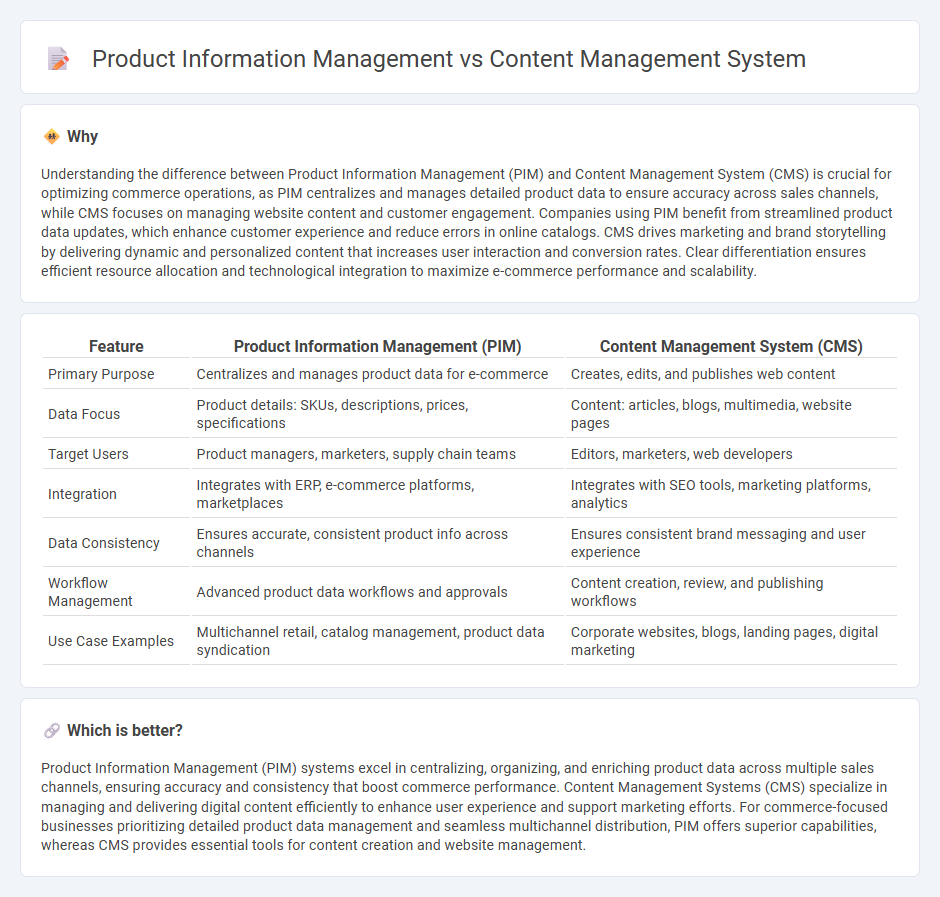
Product Information Management (PIM) centralizes and organizes product data, ensuring accuracy and consistency across sales channels, while Content Management Systems (CMS) focus on creating, managing, and publishing digital content for websites and marketing platforms. PIM enhances e-commerce efficiency by streamlining product details, attributes, and pricing, whereas CMS enables engaging content delivery and user experience. Explore the differences between PIM and CMS to optimize your commerce strategy effectively.
Why it is important
Understanding the difference between Product Information Management (PIM) and Content Management System (CMS) is crucial for optimizing commerce operations, as PIM centralizes and manages detailed product data to ensure accuracy across sales channels, while CMS focuses on managing website content and customer engagement. Companies using PIM benefit from streamlined product data updates, which enhance customer experience and reduce errors in online catalogs. CMS drives marketing and brand storytelling by delivering dynamic and personalized content that increases user interaction and conversion rates. Clear differentiation ensures efficient resource allocation and technological integration to maximize e-commerce performance and scalability.
Comparison Table
| Feature | Product Information Management (PIM) | Content Management System (CMS) |
|---|---|---|
| Primary Purpose | Centralizes and manages product data for e-commerce | Creates, edits, and publishes web content |
| Data Focus | Product details: SKUs, descriptions, prices, specifications | Content: articles, blogs, multimedia, website pages |
| Target Users | Product managers, marketers, supply chain teams | Editors, marketers, web developers |
| Integration | Integrates with ERP, e-commerce platforms, marketplaces | Integrates with SEO tools, marketing platforms, analytics |
| Data Consistency | Ensures accurate, consistent product info across channels | Ensures consistent brand messaging and user experience |
| Workflow Management | Advanced product data workflows and approvals | Content creation, review, and publishing workflows |
| Use Case Examples | Multichannel retail, catalog management, product data syndication | Corporate websites, blogs, landing pages, digital marketing |
Which is better?
Product Information Management (PIM) systems excel in centralizing, organizing, and enriching product data across multiple sales channels, ensuring accuracy and consistency that boost commerce performance. Content Management Systems (CMS) specialize in managing and delivering digital content efficiently to enhance user experience and support marketing efforts. For commerce-focused businesses prioritizing detailed product data management and seamless multichannel distribution, PIM offers superior capabilities, whereas CMS provides essential tools for content creation and website management.
Connection
Product Information Management (PIM) systems centralize and standardize product data, ensuring accuracy and consistency across all sales channels, while Content Management Systems (CMS) manage and deliver digital content such as product descriptions, images, and marketing materials. The integration between PIM and CMS enhances e-commerce platforms by synchronizing detailed product attributes with engaging content, improving the customer experience and boosting conversion rates. Effective connectivity enables real-time updates, reduces manual errors, and supports omnichannel commerce strategies.
Key Terms
Centralization
Content management systems (CMS) centralize digital content such as articles, images, and videos to streamline website management and enhance user experience. Product information management (PIM) systems focus on centralizing detailed product data including descriptions, specifications, and pricing to ensure consistency across sales channels. Discover how centralizing content and product information can optimize your business operations and customer engagement.
Workflow
A content management system (CMS) streamlines the creation, editing, and publishing of digital content, emphasizing user-friendly workflows for website management and marketing teams. Product information management (PIM) centralizes and organizes detailed product data, enhancing accuracy and consistency across sales channels with complex, data-driven workflows tailored for product lifecycle management. Explore how integrating CMS and PIM workflows can optimize overall business efficiency and drive better customer experiences.
Data Structure
A content management system (CMS) primarily organizes unstructured data like text, images, and multimedia for website content, emphasizing ease of publication and user experience. Product information management (PIM) systems specialize in structured data, centralizing detailed product attributes, specifications, and inventory information to ensure consistency across sales channels. Explore the distinctions further to optimize your digital asset and product data strategies.
Source and External Links
What is a content management system (CMS)? - A CMS is software that allows users to create, manage, and modify digital content easily without coding skills, supporting collaboration, digital asset management, and multi-channel publishing.
What Is A Content Management System (CMS)? - A CMS helps companies store, organize, edit, and publish content collaboratively through role-based workflows, combining a user-friendly interface for content creation with automated management on the backend.
Content management system - A CMS is software that manages creation and modification of digital content, typically featuring a content management application (CMA) for non-expert users and a content delivery application (CDA) for publishing updates.
 dowidth.com
dowidth.com